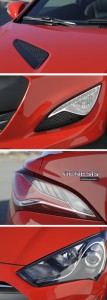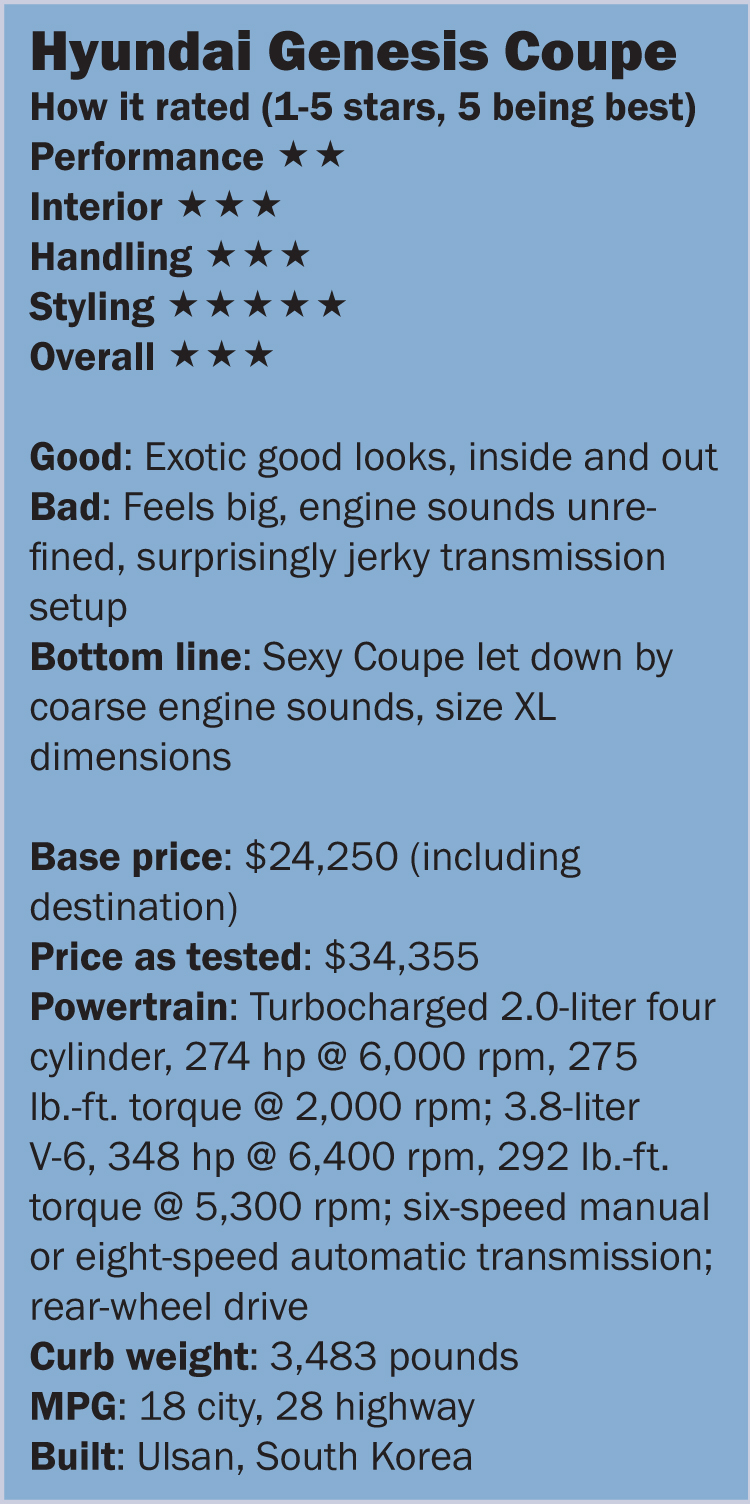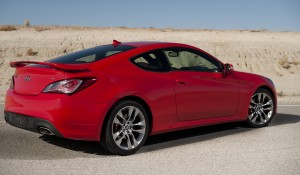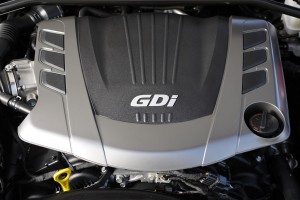There’s a lot to like about a powerful, somewhat rare, exotic-looking rear-wheel drive sports coupe. And did we mention that it’s relatively affordable?
It seems odd that Hyundai gave the coupe the same name as the four-door with which it shares a platform, the Genesis sedan. What all the other good names were taken?
But starting at just $24,250 with destination, the Genesis Coupe is a surprising value.
The coupe comes standard with the same 274-horsepower 2.0-liter turbo that makes the Hyundai Sonata a scream. The base engine is up 64 horsepower compared to last year’s model, and 74 more than the vaunted Subaru BRZ/Scion FR-S. The test car had the optional 3.8-liter V-6 with 348 horsepower, up 42 horses compared to the 2012 model, mostly thanks to the addition of direct injection.
It’s too bad the V-6 sounds like a vacuum cleaner that ate a bag full of marbles. It’s not smooth, it seems as though it makes a lot of unrefined induction sound and the exhaust is boomy, not lusty.

Cool details abound on the Genesis Coupe, from fake hood vents (top), to the cool driving lights, taillights and headlights.
That wouldn’t be so bad if it felt fast. While the Coupe’s 0-60 time drops from a shade under 6 seconds to a shade over 5.5 with the big engine, it just doesn’t feel fast. Maybe it’s just that the Genesis Coupe just feels so big. Although we haven’t driven it, it seems like the lighter turbo four might be more fun.
The Coupe feels big because it is. A lot of that is a product of its platform. Since it also supports the Genesis sedan, the coupe has generous proportions. Compared to the FR-S, it’s significantly bigger in just about every dimension. It’s 3.5 inches wider, more than 15 inches longer, nearly four inches taller and weighs 600 pounds more.
With the V-6, the Genesis Coupe actually compares more closely to the Infiniti G-Coupe, which is similar in most dimensions except width where the Genesis Coupe is 1.5 inches wider. The Hyundai is also 180 pounds lighter than the Infiniti.
Fuel economy was decent. Rated at 18 city and 28 highway (the manual loses 1 mpg on both city and highway circuits), we saw 22 mpg with a lot of freeway cruising, along with quite a bit of foot-to-the-floor acceleration blasts.
Even if the engine isn’t deserving of lust, the styling is. For 2013 Hyundai refreshed the Genesis Coupe, dialing up the styling, adding more details, such as LED accent lighting around the headlights and a more aggressive front fascia. It also added a pair of fake hood vents. The changes add to a car which already had a wide stance, with a low cowl and racy lines. The new model looks rather exotic, especially since there aren’t all that many the road.
Dressed in Shoreline Drive Blue, the car attracted attention. Anyone who found themselves parking next to it took a few extra seconds to check it out. Is that because the Coupe is relatively rare around Metro Detroit? Or are they noticing the aggressive new details? Oh, and don’t forget the cool alloy wheels which perfectly show off sexy red Brembo brake calipers.
The Genesis Coupe comes standard with a six-speed manual transmission, but the test car had the eight-speed automatic with paddle shifters. The automatic, with a traditional torque converter setup, gives the car a surprisingly jerky feeling. The car never feels smooth. Beyond that, the manumatic function is slow to give the requested shift and holding the upshift paddle doesn’t return it to automatic mode. It also upshifts on its own if you get near the redline.
The transmission has a sport mode, but it offers little discernible difference compared to the standard mode.
As is typical with the Genesis sedan, the Coupe has a very stiff ride, especially at higher speeds. But it’s a little more acceptable here since the Genesis has sporting pretensions.
The big coupe turns nicely with quick steering and it has plenty of power to push the rear wheels into power oversteer. The car tracks nicely in a straight line on the freeway, but oddly, it tends to wander in the curves at higher speeds.
 The cool styling continues inside. While some of the graining of the vinyl could be better, the instrument panel and other elements are well done. What’s odd is the trio of extra gauges on the center console. Oil temperature is a good addition, and a torque gauge is fun – but it’s calibration seems a bit off, showing 75 pound-feet just off idle – but the third gauge is for instant fuel economy, a complete useless statistic. A voltmeter or oil pressure would be a far better choice, particularly since fuel economy is available in the trip computer in the IP.
The cool styling continues inside. While some of the graining of the vinyl could be better, the instrument panel and other elements are well done. What’s odd is the trio of extra gauges on the center console. Oil temperature is a good addition, and a torque gauge is fun – but it’s calibration seems a bit off, showing 75 pound-feet just off idle – but the third gauge is for instant fuel economy, a complete useless statistic. A voltmeter or oil pressure would be a far better choice, particularly since fuel economy is available in the trip computer in the IP.
Tilting the seatback to put a briefcase back there – what you thought someone was going to sit in the tiny rear seat? – requires a long reach to the center of the seatback.
Actually, we did try the rear seat. It might be acceptable for a smaller person, but don’t make your 5-foot-10 buddy sit back there. The rear seatback folds to extend trunk space, but the seatback is not split.
One interior annoyance was a creaky sunroof that was most noticeable pulling into the driveway.
With every new model it presents, Hyundai keeps getting better. Suspension tuning has long been a problem for Hyundai and its sister company, Kia, but the Genesis Coupe shows that the Korean automaker also still has to learn some tricks in giving its sporty cars the goods that buyers want in this segment.
But does the driving experience live up to the exotic looks?



